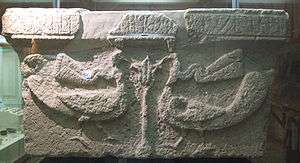Caucasian Albanian language
| Aghwan | |
|---|---|
| Old Udi | |
| Caucasian Albanian | |
| Native to | Caucasian Albania |
| Era | 6th–8th century AD. Developed into Udi[1] |
| Caucasian Albanian | |
| Language codes | |
| ISO 639-3 |
xag |
xag | |
| Glottolog |
aghw1237[2] |
 A 7th-century column capital with Caucasian Albanian text | |
Caucasian Albanian, Aghwan or Old Udi, is an extinct member of the Northeast Caucasian languages. It was spoken in Caucasian Albania, which stretched from current day south Dagestan to Azerbaijan. Linguists believe it is an early linguistic predecessor to the endangered North Caucasian Udi language.[3] Despite its name, Caucasian Albanian bears no linguistic relationship whatsoever with Albanian, the language of Albania.
Discovery and decipherment
In 1996, Zaza Aleksidze of the Centre of Manuscripts in Tbilisi, Georgia, discovered a palimpsest[4] at Saint Catherine's Monastery on Mount Sinai, Egypt, with an unknown script.[5] He went on to identify the alphabet as Caucasian Albanian,[6] and to identify the manuscript as an early Christian lectionary from about the 5th or 6th century. The lectionary may be the earliest extant lectionary in the Christian religion.[7]
Then linguists Jost Gippert and Wolfgang Schulze got involved with the Caucasian Albanian alphabet.[8] Specialized x-ray equipment with MuSIS was used, which made it possible to read the Caucasian Albanian palimpsest texts in their entirety.[9] A list of Caucasian Albanian month names, which survived in a number of medieval manuscripts, gave one of the clues to the language.[8]
Apart from the Caucasian Albanian palimpsests kept at Mt. Sinai, the most famous samples of Caucasian Albanian inscriptions were found in 1949 during excavations in Mingachevir region, Azerbaijan. Among the known Caucasian Albanian words are zow (I), own (and) and avel-om (much, ordinal form).
The deciphered text samples of the language include an excerpt from the Second Epistle to the Corinthians.[10][11]
In 2017, two additional texts of Caucasian Albanian were discovered in Saint Catherine's Monastery.[12] The original text[13] on the palimpsests was erased anywhere between the 4th and 12th century.
Phonology
Consonants
| Plosive | Fricative | Affricate | Approximant | Nasal | Trill | ||||
|---|---|---|---|---|---|---|---|---|---|
| Regular | Ejective | Regular | Ejective | ||||||
| Bilabial | p b | p’ | m | ||||||
| Labiodental | f v | ||||||||
| Alveolar | Regular | t d | t’ | s z | ts dz | ts’ | l | n | r |
| Palatalized | dʲ | tʲ’ | dzʲ | lʲ | nʲ | ||||
| Post-alveolar | ʃ ʒ | tʃ dʒ | tʃ’ | ||||||
| Alveo-palatal | ɕ ʑ | tɕ dʑ | tɕ’ | ||||||
| Palatal | j | ||||||||
| Velar | k g | k’ | x ɣ | ||||||
| Labialized velar | w | ||||||||
| Uvular | q | q’ | χ | ||||||
| Pharyngeal | ʕ | ||||||||
| Glottal | h | ||||||||
References
- ↑ Aghwan at MultiTree on the Linguist List
- ↑ Hammarström, Harald; Forkel, Robert; Haspelmath, Martin, eds. (2017). "Aghwan". Glottolog 3.0. Jena, Germany: Max Planck Institute for the Science of Human History.
- ↑ Zaza Aleksidze, "Udi Language: Comparing Ancient Albanian with Contemporary Udi," in Azerbaijan International, Vol. 11:3 (Autumn 2003), p. 43.
- ↑ Zaza Aleksidze, "Caucasian Albanian Script: The Significance of Decipherment," Azerbaijan International, Vol. 11:3 (Autumn 2003), p. 56.
- ↑ Zaza Aleksidze and Betty Blair, in "Caucasian Albanian Alphabet, Ancient Script Discovered in the Ashes," in Azerbaijan International, Vol. 11:3 (Autumn 2003), pp. 38-41.
- ↑ Zaza Aleksidze and Betty Blair, "Quick Facts: The Caucasian Albanian Script," Azerbaijan International, Vol. 11:3 (Autumn 2003), p. 43.
- ↑ Zaza Aleksidze and Betty Blair, in "The Albanian Script: The Process - How Its Secrets Were Revealed," in Azerbaijan International, Vol. 11:3 (Autumn 2003), pp. 41-51..
- 1 2 Wolfgang Schulze. "Towards a history of Udi" (PDF). Papers of the IFEA Round Table. Retrieved 2011-01-18.
- ↑ Zaza Alexidze (2007). "Discovery and Decipherment of Caucasian Albanian Writing" (PDF). Bulletin of the Georgian National Academy of Sciences. Archived from the original (PDF) on July 21, 2011. Retrieved 2011-01-18.
- ↑ See photo of Albanian script of II Corinthians 11:26-27 with its repetition of the phrase - "I was persecuted,", which helped unlock the key to the alphabet for Dr. Aleksidze.
- ↑ Wolfgang Schulze (2003). "Caucasian Albanian - Palimpsest and Inscriptions". Leibniz-Rechenzentrum. Archived from the original on 2011-07-20. Retrieved 2011-01-18.
- ↑ Scientists find languages not used since Dark Ages among ancient manuscripts recovered from monastery.
- ↑ Sarah Lasgow "Found: Hidden Examples of Long-Lost Languages in Centuries-Old Palimpsests"